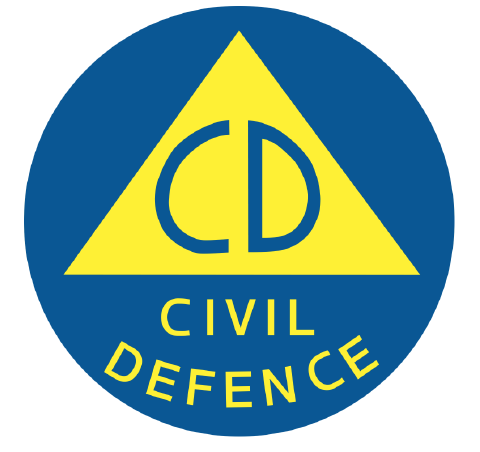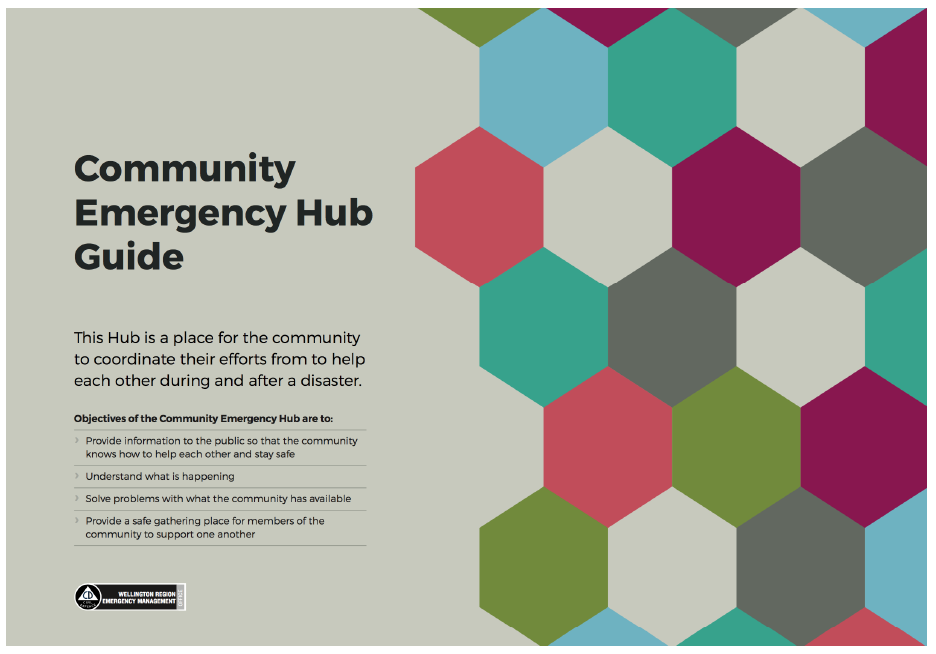Visual communication
5.3 Visual communication
Currently ‘Community Emergency Hub’ (CEH) is the term used by WREMO, pending sector agreement for a name to be applied to community led centres.
The visual language of the WREMO CEH guides are consciously different to the blue/yellow Civil Defence palette inherited from the Ministry of Civil Defence and Emergency Management and employed across the sector. The rationale for moving away from the yellow and blue palette has been to clearly delineate this as a community, not a WREMO document. How this relationship between ‘community’ information and WREMO or other official information is managed in Prepare Wellington will need careful consideration.
The shared equities that make up the ‘identity’ of the sector (e.g. the colour palette; round circle with yellow triangle CD icon; chevron patterns and to a certain extent the name ‘Civil Defence’) do convey a sense of recognition and credibility in the minds of the audience. There is a tension to balance between a visual vocabulary that semiotically suggests knowledge, expertise and authority, and with the need to avoid a suggestion that civil defence is something that is provided to a community, not developed and managed within a community. The strength of WREMO’s 'brand' is associated with high levels of goodwill and trust, and is therefore a powerful tool for engaging potential users, attesting by association to the platform’s quality, reliability and purpose.
It may be possible to shift perception whilst retaining a useful visual shorthand that is already established (in fact, many survey respondents framed the term civil defence as involving community). There is a case to be made too that retaining a sector-wide identity allows the public to make quick credibility judgements about a source, especially online. A consistent sector identity (beyond the scope of this project) also allows for scaling of a tool with little aesthetic intervention. The Hub Guide retains the WREMO logo, and it is possible that this common thread is enough to leverage WREMO’s reputation.
5.3.1 What does civil defence mean to you?
Although this design research is not intended to inform the brand values of WREMO itself, understanding the contemporary public’s perception of what “Civil Defence” means, helps to inform how the Development should be undertaken in line with the New Zealand Government Web Accessibility Standard 1.0.
Before development commences, UI and UX specifications and guidelines that govern the application’s behaviour and how people’s data is respected should be developed.
experience may be visually represented. This perception issue is related to the vital issue integral to reputation and trust as mentioned above. The following example responses were drawn from the survey mentioned in §6.2 (above).
A sample of survey responses to the question ‘What does civil defence mean to you?’
“Taking care of people in a widespread emergency situation”
“Communities, with help from local and central government, being prepared to cope in the event of an emergency”
“People have to organise themselves in an emergency”
“Storing emergency water, alternate cooking, reserves of canned food, looking after ourselves”
“Ensuring my family are safe, and then local community safety”
“Planning for and reaction to natural disasters/severe events”
5.3.2 Accessibility considerations
Accessibility refers to the inclusive practice of removing barriers that prevent interaction with, or access to websites, by people with disabilities. This could include blind or visually impaired (including colour blind), hearing impaired, mobility impaired or cognitively impaired users. Though not technically an accessibility consideration, a range of languages in an increasingly multicultural Wellington and Wairarapa region should be provided for.
Development should be undertaken in line with the New Zealand Government Web Accessibility Standard 1.0.
Before development commences, UI and UX specifications and guidelines that govern the application’s behaviour and how people’s data is respected should be developed.

Web accessibility issues: blindness, visual impairment, hearing impairment, mobility impairment or cognitive impairment

